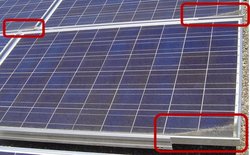Part 1
Cleaning Your Solar Panels: One obvious yet often overlooked cause of a decline in the efficiency of your solar panel is the presence of dirt. Depending on your location, pollen, sand and other debris could be the culprit. When dirt accumulates on the solar panels it decreases the amount of solar radiation available for use, so in order to get the most out of your solar panels, frequent inspection and cleaning should be done. Tilted panels can be cleaned less often dueto rain runoff, a benefit flat panels do not have. 
Tools You’ll Need: Ladder, Warm Water, Soft Rags, Dish Washing Soap or Chemical Free Cleaners. Warm water can initially be used to remove the majority of the dirt. If there are still spots on the panel a combination of water and dish soap or natural cleaners can be used along with a soft rag to gently wipe away the remaining debris. Other options include auto cleaning systems which make it easier to keep panels clean in harder to reach areas. One obvious yet often overlooked cause of a decline in the efficiency of your solar panel is the presence of dirt. Depending on your location, pollen, sand and other debris could be the culprit. When dirt accumulates on the solar panels it decreases the amount of solar radiation available for use, so in order to get the most out of your solar panels, frequent inspection and cleaning should be done. Tilted panels can be cleaned less often due to rain runoff, a benefit flat panels do not have. Google Proves the Benefits of Cleaning Your Solar PanelsGoogle’s headquarters located in Mountain View, CA has the largest corporate installation of solar panels in the United States with a 1.6 megawatt system. They decided to do an experiment to find out how much dirt actually affected their solar panel’s efficiency. The study began by comparing the two different sets of solar panels in Google campus - the flat ones in carports and the tilted ones on roofs. Understandably, dirt accumulates on top of the flat panels, while rain washes away most dirt atop the tilted ones, leaving some accumulation in the corners. A full 15 months after installation of the panels, the Google crew cleaned them up as part of this study. For the flat panels, the result was astounding -energy output doubled overnight. For the tilted panels though, the difference in output is "relatively" small. After this first experiment, the Google crew waited another eight months and cleaned the panels again, with the flat panels exhibiting in a 36 percent improvement in efficiency. Taking these results into account, the Google crew decided to clean the flat panels regularly, leaving the tilted ones out because the difference in output is negligible.
Rains Cleaning Affects: Tilted solar panels -Visual inspection indicates that rain does
clean them quite well.
-However, dirt does accumulate in the bottom most corner of the solar panels

Non-tilted solar panels -Rain does not clean dirt off horizontal, non-tilted solar panels. -Rain, mixed in with dirt that had settled on the solar panels, does not drain well due to the solar panel’s frame structure. -3 millimeter depth between the solar module metal frame and the glass surface where dirty water can accumulate B47 Parking and B45 Parking PV 0utput doubled after B45 Parking & B47 Parking solar panels were cleaned for the first time in 15 months represented by their peaks on between 8/11/2008 to 9/11/2008 Output increased by 36% after these solar panels were cleaned again 8 months later represented by their spikes in after 5/11/2009. Next Week in Part Two Of the Series We Will Look at Ground Mount Vs. Roof Mount What's the Best Choice for Your Project? |







